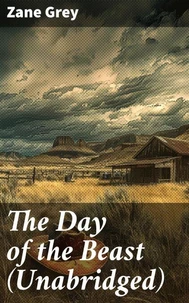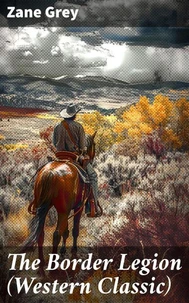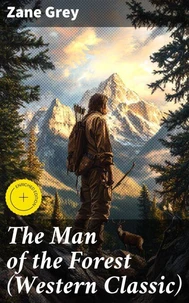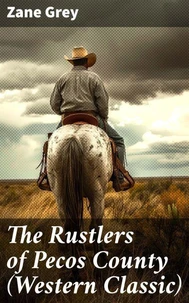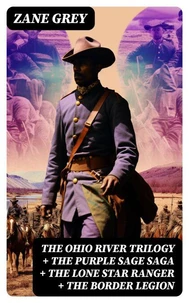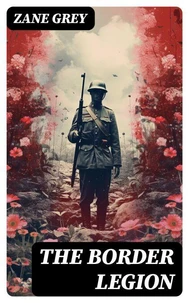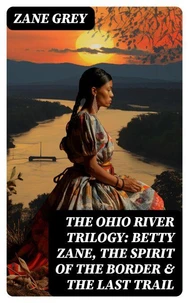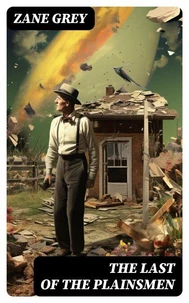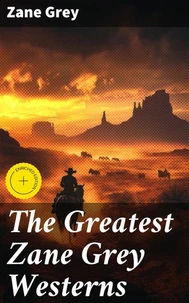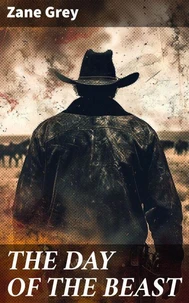The Rainbow Trail
Par :Formats :
Disponible dans votre compte client Decitre ou Furet du Nord dès validation de votre commande. Le format ePub est :
- Compatible avec une lecture sur My Vivlio (smartphone, tablette, ordinateur)
- Compatible avec une lecture sur liseuses Vivlio
- Pour les liseuses autres que Vivlio, vous devez utiliser le logiciel Adobe Digital Edition. Non compatible avec la lecture sur les liseuses Kindle, Remarkable et Sony
 , qui est-ce ?
, qui est-ce ?Notre partenaire de plateforme de lecture numérique où vous retrouverez l'ensemble de vos ebooks gratuitement
Pour en savoir plus sur nos ebooks, consultez notre aide en ligne ici
- Nombre de pages333
- FormatePub
- ISBN978-3-98647-220-7
- EAN9783986472207
- Date de parution28/09/2021
- Protection num.Digital Watermarking
- Taille857 Ko
- Infos supplémentairesepub
- ÉditeurMario Huehne
Résumé
The Rainbow Trail Zane Grey - The Rainbow Trail, also known as The Desert Crucible, is Western author Zane Grey's sequel to Riders of the Purple Sage. Originally published under the title The Rainbow Trail in 1915, it was re-edited and re-released in recent years as The Desert Crucible with the original manuscript that Grey submitted to publishers.
The novel takes place ten years after events of Riders of the Purple Sage.
The wall to Surprise Valley has broken, and Jane Withersteen is forced to choose between Lassiter's life and Fay Larkin's marriage to a Mormon. Both novels are notable for their protagonists' mild opposition to Mormon polygamy, but in The Rainbow Trail this theme is treated more explicitly. The plots of both books revolve around the victimization of women in the Mormon culture: events in Riders of the Purple Sage are centered on the struggle of a Mormon woman who sacrifices her wealth and social status to avoid becoming a junior wife of the head of a local church, while The Rainbow Trail contrasts the older Mormons with the rising generation of Mormon women who will not tolerate polygamy and Mormon men who do not seek it.
The wall to Surprise Valley has broken, and Jane Withersteen is forced to choose between Lassiter's life and Fay Larkin's marriage to a Mormon. Both novels are notable for their protagonists' mild opposition to Mormon polygamy, but in The Rainbow Trail this theme is treated more explicitly. The plots of both books revolve around the victimization of women in the Mormon culture: events in Riders of the Purple Sage are centered on the struggle of a Mormon woman who sacrifices her wealth and social status to avoid becoming a junior wife of the head of a local church, while The Rainbow Trail contrasts the older Mormons with the rising generation of Mormon women who will not tolerate polygamy and Mormon men who do not seek it.
The Rainbow Trail Zane Grey - The Rainbow Trail, also known as The Desert Crucible, is Western author Zane Grey's sequel to Riders of the Purple Sage. Originally published under the title The Rainbow Trail in 1915, it was re-edited and re-released in recent years as The Desert Crucible with the original manuscript that Grey submitted to publishers.
The novel takes place ten years after events of Riders of the Purple Sage.
The wall to Surprise Valley has broken, and Jane Withersteen is forced to choose between Lassiter's life and Fay Larkin's marriage to a Mormon. Both novels are notable for their protagonists' mild opposition to Mormon polygamy, but in The Rainbow Trail this theme is treated more explicitly. The plots of both books revolve around the victimization of women in the Mormon culture: events in Riders of the Purple Sage are centered on the struggle of a Mormon woman who sacrifices her wealth and social status to avoid becoming a junior wife of the head of a local church, while The Rainbow Trail contrasts the older Mormons with the rising generation of Mormon women who will not tolerate polygamy and Mormon men who do not seek it.
The wall to Surprise Valley has broken, and Jane Withersteen is forced to choose between Lassiter's life and Fay Larkin's marriage to a Mormon. Both novels are notable for their protagonists' mild opposition to Mormon polygamy, but in The Rainbow Trail this theme is treated more explicitly. The plots of both books revolve around the victimization of women in the Mormon culture: events in Riders of the Purple Sage are centered on the struggle of a Mormon woman who sacrifices her wealth and social status to avoid becoming a junior wife of the head of a local church, while The Rainbow Trail contrasts the older Mormons with the rising generation of Mormon women who will not tolerate polygamy and Mormon men who do not seek it.


